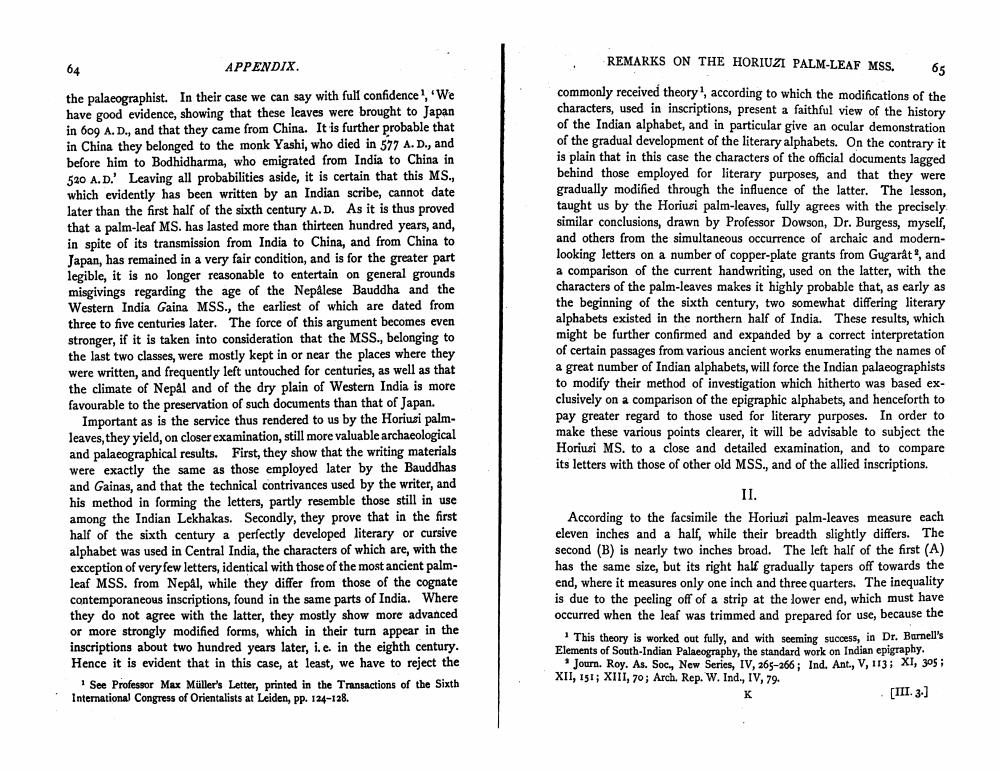________________
APPENDIX
REMARKS ON THE HORIUZI PALM-LEAF MSS.
the palaeographist. In their case we can say with full confidence 'We have good evidence, showing that these leaves were brought to Japan in 609 A.D., and that they came from China. It is further probable that in China they belonged to the monk Yashi, who died in 577 A.D., and before him to Bodhidharma, who emigrated from India to China in 520 A.D.' Leaving all probabilities aside, it is certain that this MS., which evidently has been written by an Indian scribe, cannot date later than the first half of the sixth century A.D. As it is thus proved that a palm-leaf MS. has lasted more than thirteen hundred years, and, in spite of its transmission from India to China, and from China to Japan, has remained in a very fair condition, and is for the greater part legible, it is no longer reasonable to entertain on general grounds misgivings regarding the age of the Nepalese Bauddha and the Western India Gaina MSS., the earliest of which are dated from three to five centuries later. The force of this argument becomes even stronger, if it is taken into consideration that the MSS., belonging to the last two classes, were mostly kept in or near the places where they were written, and frequently left untouched for centuries, as well as that the climate of Nepal and of the dry plain of Western India is more favourable to the preservation of such documents than that of Japan.
Important as is the service thus rendered to us by the Horiusi palmleaves, they yield, on closer examination, still more valuable archaeological and palaeographical results. First, they show that the writing materials were exactly the same as those employed later by the Bauddhas and Gainas, and that the technical contrivances used by the writer, and his method in forming the letters, partly resemble those still in use among the Indian Lekhakas. Secondly, they prove that in the first half of the sixth century a perfectly developed literary or cursive alphabet was used in Central India, the characters of which are, with the exception of very few letters, identical with those of the most ancient palmleaf MSS. from Nepal, while they differ from those of the cognate contemporaneous inscriptions, found in the same parts of India. Where they do not agree with the latter, they mostly show more advanced or more strongly modified forms, which in their turn appear in the inscriptions about two hundred years later, i.e. in the eighth century. Hence it is evident that in this case, at least, we have to reject the
See Professor Max Müller's Letter, printed in the Transactions of the Sixth International Congress of Orientalists at Leiden, pp. 124-128.
commonly received theory according to which the modifications of the characters, used in inscriptions, present a faithful view of the history of the Indian alphabet, and in particular give an ocular demonstration of the gradual development of the literary alphabets. On the contrary it is plain that in this case the characters of the official documents lagged behind those employed for literary purposes, and that they were gradually modified through the influence of the latter. The lesson, taught us by the Horiusi palm-leaves, fully agrees with the precisely similar conclusions, drawn by Professor Dowson, Dr. Burgess, myself, and others from the simultaneous occurrence of archaic and modernlooking letters on a number of copper-plate grants from Gugarát, and a comparison of the current handwriting, used on the latter, with the characters of the palm-leaves makes it highly probable that, as early as the beginning of the sixth century, two somewhat differing literary alphabets existed in the northern half of India. These results, which might be further confirmed and expanded by a correct interpretation of certain passages from various ancient works enumerating the names of a great number of Indian alphabets, will force the Indian palaeographists to modify their method of investigation which hitherto was based exclusively on a comparison of the epigraphic alphabets, and henceforth to pay greater regard to those used for literary purposes. In order to make these various points clearer, it will be advisable to subject the Horius MS. to a close and detailed examination, and to compare its letters with those of other old MSS., and of the allied inscriptions.
II.
According to the facsimile the Horiusi palm-leaves measure each eleven inches and a half, while their breadth slightly differs. The second (B) is nearly two inches broad. The left half of the first (A) has the same size, but its right half gradually tapers off towards the end, where it measures only one inch and three quarters. The inequality is due to the peeling off of a strip at the lower end, which must have occurred when the leaf was trimmed and prepared for use, because the
This theory is worked out fully, and with seeming success, in Dr. Barnell's Elements of South Indian Palaeography, the standard work on Indian epigraphy,
Journ. Roy. As. Soc., New Series, IV, 265-266; Ind. Ant., V, 113; XI, 305; XII, 151; XIII, 70; Arch. Rep. W. Ind., IV, 79.
(III. 3.)




